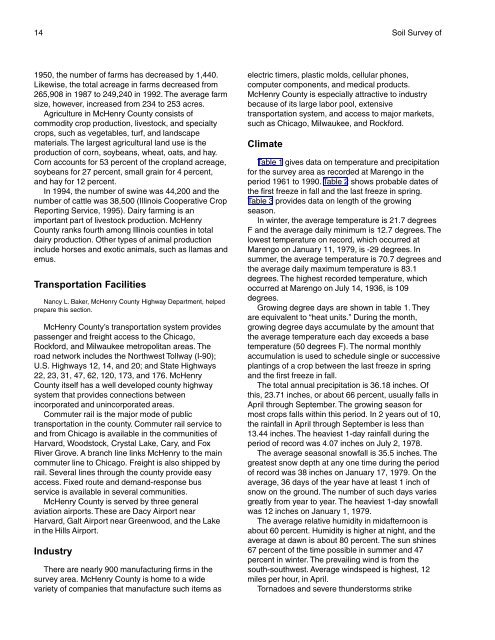Soil Survey of McHenry County, Illinois Part I - Soil Data Mart
Soil Survey of McHenry County, Illinois Part I - Soil Data Mart
Soil Survey of McHenry County, Illinois Part I - Soil Data Mart
Create successful ePaper yourself
Turn your PDF publications into a flip-book with our unique Google optimized e-Paper software.
14 <strong>Soil</strong> <strong>Survey</strong> <strong>of</strong><br />
1950, the number <strong>of</strong> farms has decreased by 1,440.<br />
Likewise, the total acreage in farms decreased from<br />
265,908 in 1987 to 249,240 in 1992. The average farm<br />
size, however, increased from 234 to 253 acres.<br />
Agriculture in <strong>McHenry</strong> <strong>County</strong> consists <strong>of</strong><br />
commodity crop production, livestock, and specialty<br />
crops, such as vegetables, turf, and landscape<br />
materials. The largest agricultural land use is the<br />
production <strong>of</strong> corn, soybeans, wheat, oats, and hay.<br />
Corn accounts for 53 percent <strong>of</strong> the cropland acreage,<br />
soybeans for 27 percent, small grain for 4 percent,<br />
and hay for 12 percent.<br />
In 1994, the number <strong>of</strong> swine was 44,200 and the<br />
number <strong>of</strong> cattle was 38,500 (<strong>Illinois</strong> Cooperative Crop<br />
Reporting Service, 1995). Dairy farming is an<br />
important part <strong>of</strong> livestock production. <strong>McHenry</strong><br />
<strong>County</strong> ranks fourth among <strong>Illinois</strong> counties in total<br />
dairy production. Other types <strong>of</strong> animal production<br />
include horses and exotic animals, such as llamas and<br />
emus.<br />
Transportation Facilities<br />
Nancy L. Baker, <strong>McHenry</strong> <strong>County</strong> Highway Department, helped<br />
prepare this section.<br />
<strong>McHenry</strong> <strong>County</strong>’s transportation system provides<br />
passenger and freight access to the Chicago,<br />
Rockford, and Milwaukee metropolitan areas. The<br />
road network includes the Northwest Tollway (I-90);<br />
U.S. Highways 12, 14, and 20; and State Highways<br />
22, 23, 31, 47, 62, 120, 173, and 176. <strong>McHenry</strong><br />
<strong>County</strong> itself has a well developed county highway<br />
system that provides connections between<br />
incorporated and unincorporated areas.<br />
Commuter rail is the major mode <strong>of</strong> public<br />
transportation in the county. Commuter rail service to<br />
and from Chicago is available in the communities <strong>of</strong><br />
Harvard, Woodstock, Crystal Lake, Cary, and Fox<br />
River Grove. A branch line links <strong>McHenry</strong> to the main<br />
commuter line to Chicago. Freight is also shipped by<br />
rail. Several lines through the county provide easy<br />
access. Fixed route and demand-response bus<br />
service is available in several communities.<br />
<strong>McHenry</strong> <strong>County</strong> is served by three general<br />
aviation airports. These are Dacy Airport near<br />
Harvard, Galt Airport near Greenwood, and the Lake<br />
in the Hills Airport.<br />
Industry<br />
There are nearly 900 manufacturing firms in the<br />
survey area. <strong>McHenry</strong> <strong>County</strong> is home to a wide<br />
variety <strong>of</strong> companies that manufacture such items as<br />
electric timers, plastic molds, cellular phones,<br />
computer components, and medical products.<br />
<strong>McHenry</strong> <strong>County</strong> is especially attractive to industry<br />
because <strong>of</strong> its large labor pool, extensive<br />
transportation system, and access to major markets,<br />
such as Chicago, Milwaukee, and Rockford.<br />
Climate<br />
Table 1 gives data on temperature and precipitation<br />
for the survey area as recorded at Marengo in the<br />
period 1961 to 1990. Table 2 shows probable dates <strong>of</strong><br />
the first freeze in fall and the last freeze in spring.<br />
Table 3 provides data on length <strong>of</strong> the growing<br />
season.<br />
In winter, the average temperature is 21.7 degrees<br />
F and the average daily minimum is 12.7 degrees. The<br />
lowest temperature on record, which occurred at<br />
Marengo on January 11, 1979, is -29 degrees. In<br />
summer, the average temperature is 70.7 degrees and<br />
the average daily maximum temperature is 83.1<br />
degrees. The highest recorded temperature, which<br />
occurred at Marengo on July 14, 1936, is 109<br />
degrees.<br />
Growing degree days are shown in table 1. They<br />
are equivalent to “heat units.” During the month,<br />
growing degree days accumulate by the amount that<br />
the average temperature each day exceeds a base<br />
temperature (50 degrees F). The normal monthly<br />
accumulation is used to schedule single or successive<br />
plantings <strong>of</strong> a crop between the last freeze in spring<br />
and the first freeze in fall.<br />
The total annual precipitation is 36.18 inches. Of<br />
this, 23.71 inches, or about 66 percent, usually falls in<br />
April through September. The growing season for<br />
most crops falls within this period. In 2 years out <strong>of</strong> 10,<br />
the rainfall in April through September is less than<br />
13.44 inches. The heaviest 1-day rainfall during the<br />
period <strong>of</strong> record was 4.07 inches on July 2, 1978.<br />
The average seasonal snowfall is 35.5 inches. The<br />
greatest snow depth at any one time during the period<br />
<strong>of</strong> record was 38 inches on January 17, 1979. On the<br />
average, 36 days <strong>of</strong> the year have at least 1 inch <strong>of</strong><br />
snow on the ground. The number <strong>of</strong> such days varies<br />
greatly from year to year. The heaviest 1-day snowfall<br />
was 12 inches on January 1, 1979.<br />
The average relative humidity in midafternoon is<br />
about 60 percent. Humidity is higher at night, and the<br />
average at dawn is about 80 percent. The sun shines<br />
67 percent <strong>of</strong> the time possible in summer and 47<br />
percent in winter. The prevailing wind is from the<br />
south-southwest. Average windspeed is highest, 12<br />
miles per hour, in April.<br />
Tornadoes and severe thunderstorms strike

















